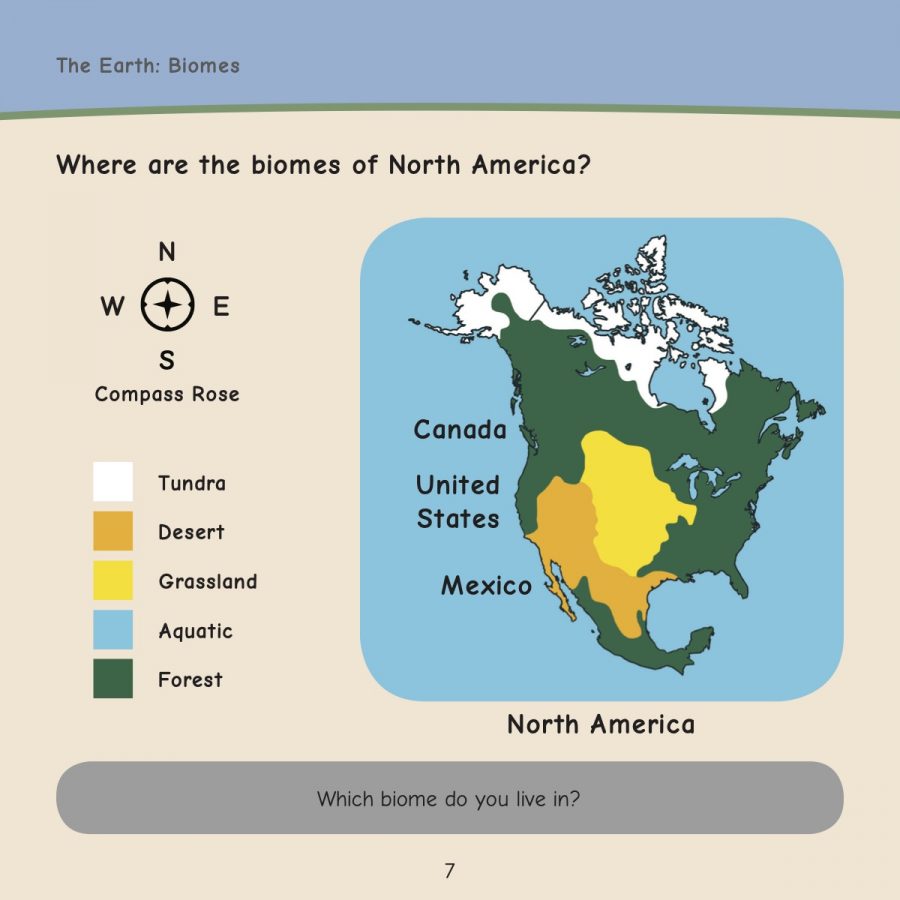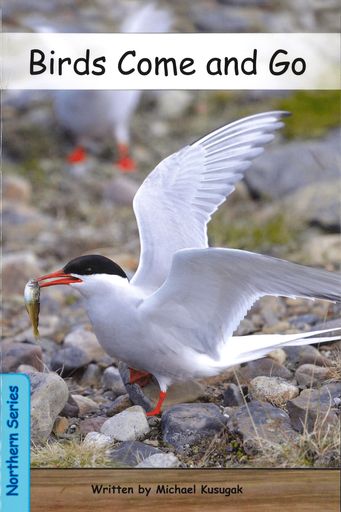Biomes are large ecological areas. Each biome is defined by its climate, vegetation, wildlife,7and geology. There are five kinds of biomes on Earth: tundra, desert, grassland, aquatic, and forest.
All these biomes are found in North America. Each biome consists of a large number of ecosystems with common characteristics.

Photo Credit: Strong Nations Publishing from the book The Earth, Our Home.
ARCTIC TUNDRA BIOME
The Arctic tundra biome is located in the northern areas of the world— in Nunavut, the Yukon, the Northwest Territories, Northeastern Manitoba, Northern Quebec, Northern Ontario, and Northern Labrador in Canada.
The top layer of soil on the Arctic tundra is very thin. It freezes and thaws with the changes in temperature. The soil underneath this layer is called permafrost because it stays frozen all year long.
When the snow and the top layer of soil melt during the short spring and summer, large amounts of freshwater are left behind. A wide variety of migrating birds settles in these wetlands to nest. The availability of fresh water, wet soil, and twenty-four hours of sunshine facilitate the growth of many low-lying plants such as mosses, grasses, lichens, and sedges. These plants play a crucial role in the food chains and food webs of many Arctic tundra animals.
The following resources provide information about the Arctic tundra biome.
BOOKS (FICTION AND NON-FICTION)
 A Children’s Guide to Arctic Butterflies
A Children’s Guide to Arctic Butterflies
by Mia Pelletier
Inhabit Media
ISBN 978-1-77227-177-5
Without layers of blubber, thick furry coats, or downy feathers, how do Arctic butterflies survive in the harsh Arctic climate? In A Children’s Guide to Arctic Butterflies, the author describes how twelve varieties of these hardy creatures survive from one season to the next.
This beautifully illustrated book is filled with information about each of the twelve butterflies and also includes descriptions of the parts of a butterfly, the butterfly life cycle, strategies for staying warm, and ways that butterflies survive an Arctic winter.
 Inuit, Tundra and Ravens
Inuit, Tundra and Ravens
by Michael Kusugak, Brenda Boreham, and Terri Mack
Strong Nations Publishing
ISBN 978-1-77174-247-4
Inuit, Tundra and Ravens describes and explores the Arctic tundra with a focus on the raven as one animal that has adapted to living there year-round. Michael Kusugak, who was born in Qatiktalik and grew up in Naujaat (Repulse Bay), responds to questions about life in the Arctic. This well-illustrated non-fiction book is filled with text features to assist readers, including maps, charts, diagrams, captions, labels, word boxes, fact boxes, and bold words.
 Birds Come and Go
Birds Come and Go
by Michael Kusugak
Strong Nations Publishing
ISBN 978-1-77174-061-6
This little book is part of the Strong Readers: Northern Series—a collection of guided reading books focussed on the Canadian north. Birds Come and Go (Level 15) introduces some migratory birds to young readers. Snow buntings, sandhill cranes, seagulls, Canada geese, tundra swans, Arctic terns and ravens are all pictured, and interesting facts are given for each.
 Niam!
Niam!
Cooking with Kids
by Kerry McCluskey
Inhabit Media
ISBN 978-1-77227-255-0
“Niam” is an Inuktitut word that means “yum,” a very appropriate title for a book full of tasty, simple, and kid-friendly recipes. The idea for the book originated with the Mamaqtuq Nanook Cooking Club at Nanook School in Apex, Nunavut. Each recipe includes a list of the required skills, the ingredients, and directions, and can be made with country foods or store-bought ingredients. This book also includes a glossary, an explanation of cooking terms, abbreviations for measurements, teaching tips, suggestions for community involvement, and traditional Inuit knowledge.
 Caribou
Caribou
by Dorothy and David Aglukark
Inhabit Media
ISBN 978-1-77227-234-5
This new addition to the Animals Illustrated series is well organized, richly illustrated, and filled with interesting facts about caribou. Focussing closely on the barren-ground caribou, this book explores a number of topic areas including the appearance, range, diet, raising of the young, common predators, herd behaviour, and communication.
Young readers are well supported by a number of non-fiction text features, such as captions and a labelled diagram. For students who are engaged in research and report writing activities, this book would make a great resource.
 The Caterpillar Woman
The Caterpillar Woman
by Nadia Sammurtok
Inhabit Media
ISBN 978-1-77227-083-9
The Caterpillar Woman is the retelling of a traditional Inuit story. The main character, Piujuq, lives in self-isolation on the tundra because she thinks that no one could accept her strange and frightening appearance. Eventually, after many seasons, a stranger arrives and sees beyond her exterior and into her kind heart.
DOCUMENTARIES
 The Barren-Ground Caribou
The Barren-Ground Caribou
YouTube
Running Time – 4:32
This WWF Canada video describes the connections between the barren-ground caribou and the other plants and animals in tundra biome. It also highlights the conservation challenges brought about by industrial development and climate change in the north.
 Searching for Caribou in the Arctic Barren Lands
Searching for Caribou in the Arctic Barren Lands
YouTube
Running Time – 9:23
Episode 4 in the series EXPOSED Wildlife Conservancy with John Marriott, this video highlights the barren-ground caribou and the aurora borealis and has great shots of the Arctic tundra at the beginning of the fall migration season.
LEARNING ACTIVITY
There are a number of videos and films about the Arctic tundra that are suitable for classroom use for a wide range of grade levels. After viewing an appropriate video, students could respond to the content by using the following format.

Note: The video review form can be found on page 20 of the Teacher’s Guide for The Cedar Club Forest Detectives from Pacific Edge Publishing Ltd.
ABOUT THE AUTHOR
Brenda Boreham
Brenda has 35 years of classroom experience. She has presented workshops on literacy strategies, and has written a number of resources for teachers. She remains passionate about matching up kids with books.
This article appears in Canadian Teacher Magazine’s Spring 2021 issue.









